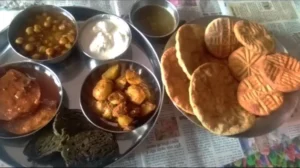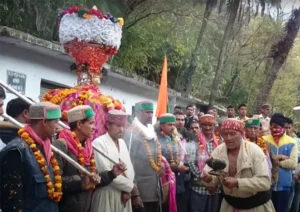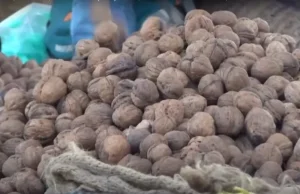One of the many festivals of Himachal is Sair festival which is celebrated on the first day of Ashwin month. The first day of the Hindu calendar months is called Sagrand (Sankranti). Every Sagrand is not celebrated as a festival, but some Sagrands are elebrated as a special festival.
The Sagrand of Ashwin Mass is celebrated as Sair festival. Sair festival is specially celebrated in Kangra, Kullu, Mandi, Shimla, Solan, Hamirpur and Bilaspur. In today’s article, you will know about Sair festival in detail.
What is Sair Festival
Sair is a festival that holds a special place in the heart of every Himachali. Though Sair festival is known by different names in Himachal (Sair, Shoiri ra Saza, Sayar) but the essence and method of celebrations remains almost the same with mild differences about which we will talk later on in this article.
Sair festival celebration begins on the previous night of Sair. People cook delicious local dishes that include ghadvi rotiyan, mithdu, pakodu, gulgule, patrode, paneer, mutton etc.

Every member of the house is very busy on the day of the Sair, the male members of the house greet the people of the neighborhood in the morning and invite them to eat in their house. Women collect some of the fruits and crops from their fields.
Women decorate a plate in which some fruits, some grains, vermilion, sweets, etc. are kept. This plate decorated with various things is kept in the worship house. Then a special puja of Sairi Mata is performed and the gods are thanked for a good harvest. This plate is kept in the house of worship for the whole day.

The elders of the house then give halwa, walnuts and money to the children. All the younger ones in the house take blessings by touching the feet of their elders.The next day the Sairi thaali is emptied in the bags of village barber who comes to wish Sair to each house in the village.
Based on the Himachal legends, Lohri and Sair were actual sisters. Sair was wedded into a humble household, leading to its celebration in September. The dishes associated with Sair are not only delectable but also economical. On the other hand, Lohri was married into an affluent family, resulting in the festival being marked by grand festivities and a plethora of sweets such as desi ghee treats, chivda, peanuts, and khichdi.
Why Sair is Celebrated ?
People celebrate the festival of Sair primarily to express gratitude to God for a successful kharif crop. Additionally, Sair signifies the transition from the monsoon season to winter and the end of one season and the start of another.
In Himachal Pradesh, each village has its own Deity, leading residents to worship and extend their welcome to these Deities on this particular day. According to popular belief, on this day, Deities descend from heaven to the earthly realm, and people greet their arrival by playing drums.

This day marks the conclusion of the Bhadon month. Throughout this month, the deities exit their temples to engage in battles against witches. They return to their respective temples on the occasion of Sair.
During Sair, in rural temples, the spiritual leaders of the gods and goddesses inform the people about the outcomes of the battles between the deities and witches. They also reveal which side emerged victorious in these encounters.

In the past, numerous individuals succumbed to illnesses during the monsoon period due to the lack of proper healthcare facilities. This made the monsoon period widely regarded as unfavorable. Consequently, as the winter season arrives on the day of Sair, all diseases vanish, prompting people to enthusiastically celebrate the occasion.
Back in the past, when heavy rains were frequent, people had fewer chances to meet due to the challenges of navigating overflowing river drains during these downpours. It was only after the rainy season, on the Occasion of the Sair festival, that people could finally come together. Thus, Sair serves as a celebration of not only the end of the rainy season but also the values of mutual harmony, brotherhood, and the joy of reuniting with friends and relatives.
During Sair, newlywed brides make their way back to their in-laws’ home from their maternal residence. In Himachal Pradesh, there’s a belief that in the first year of marriage, brides refrain from seeing their mother-in-law’s face throughout the Bhadon month. In such circumstances, brides visit their maternal home for a month and return on the Occasion of Sair.
How Sair is celebrated ?
Sair festival stands as a celebration of feasting. As previously mentioned, a variety of dishes are meticulously prepared, and people are warmly invited to partake in the feast. The delectable treats are also shared generously within the community.
During Sair, people form groups to visit each other’s homes and indulge in refreshments at each stop. Beverages are offered as well. It’s customary for the younger individuals to show their respect by touching the feet of their elders and seeking their blessings.
Moreover, Sair can also be aptly termed as the Walnut Festival. The streets bustle with walnut vendors, and people exchange walnuts with one another. Children can be spotted playing with walnuts on the streets. A popular game involves participants contributing one walnut each, and then taking turns to toss their walnuts into a hole in the ground.

There are two ways to secure walnuts in this game: by successfully landing walnuts inside the hole or by skillfully striking one of the remaining walnuts outside the hole using a chipped stone known as “Bhutta.”
In the Kullu district, a unique tradition involves the exchange of “Jubba” during Sair. Jubba is a type of grass. Males place Jubba within their Pahari Topi (traditional cap), while females tuck it behind their ears.

In Solan’s Arki and Shimla’s Mashobra, a unique event of bullfighting takes place (currently banned). Around 50 bulls are typically assembled for this festive spectacle. Before these contests, the bulls are also served with alcohol.
Conclusion
In conclusion, the Sair Festival, celebrated on the first day of the Ashwin month, holds deep significance in Himachal Pradesh. With its roots tracing back to expressions of gratitude for bountiful harvests, the festival marks the transition from monsoon to winter, uniting communities in joyous feasting and cherished traditions.
Through vibrant rituals and shared meals, Sair embodies the values of harmony, togetherness, and the spirit of renewal. As families gather, blessings are exchanged, and unique customs unfold, Sair Festival showcases the rich cultural tapestry and heartfelt connections that thrive in the heart of Himachal.
FAQ’s
What is date of Sair 2023
Sair 2023 will be celebrated on 17th of September 2023
